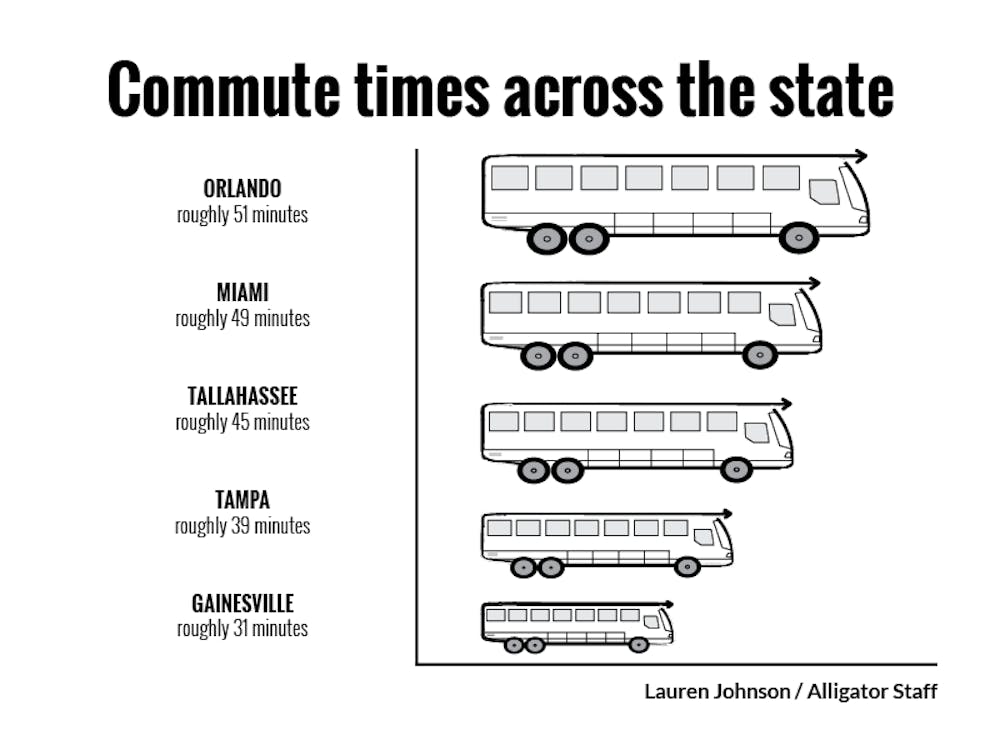Oswaldo Reina takes the bus to work at the Rawlings POD Market at least three times a week.
“I’d rather ride a bus than buy a decal,” the UF construction engineering graduate student said.
With the Regional Transit System buses serving about 30 passengers an hour last July, Reina isn’t the only one opting to take the bus.
This could be because Gainesville’s public transportation takes about 18 minutes less than the national average, according to a report by the Associated Press.
Commute times in Gainesville are lower overall than the rest of the country, according to the AP report. Of the major Florida cities included, Gainesville has the shortest time in the state.
Whereas Gainesville residents spend an average of 31 minutes on public transit, those in the Orlando area spend an average of 51 minutes, and those in Tallahassee spend an average of 45 minutes.
In Gainesville, there’s a mix of transportation methods, which alleviates congestion on roads, said UF urban and regional planning professor Ruth Steiner.
“We have the right options,” she said.
Although the university doesn’t always have available on-campus parking, Steiner said it makes up for it with a partnership with RTS.
The university’s RTS partnership affects all commuters, even those driving and carpooling, said Marlie Sanderson, the director of transportation planning for the North Central Florida Regional Planning Council.
When people ride buses, it takes cars off of the road, he said. This impacts the community as a whole, lessening traffic on overcrowded roads like 13th Street, West University Avenue, Southwest 34th Street and Archer Road.
Compared to 10 years ago, Sanderson said more students are choosing not to ride their bikes, opting instead to ride the bus.
“Those people have better options with better bus service,” Sanderson said, explaining that buses run more frequently and extensively now than they did a decade ago.
To solve the traffic problems that arise, Sanderson said the city could widen existing roads and expand the bus services, which would alleviate traffic problems. The city does not have the funding to do that, though. Last fall, voters didn’t pass a transportation sales tax.
For Reina, it’s easy to take the bus to campus, and he said he likes having the option to drive or use RTS. In his hometown, Caracas, Venezuela, Reina said public transit is always overcrowded.
“It’s nice to have that opportunity to come to work in different ways,” he said.
Natalia Neira also said she used the bus to get to class, but the property management company she worked for needed her to travel all over the city, requiring her to drive.
Still, the UF urban and regional planning graduate student said she rarely had problems with RTS, and she liked how quick it was.
“It took me longer to get to the (bus) stop than to actually get to campus,” the 25-year-old said.
Gainesville’s traffic is incomparable to other cities, like her hometown, Miami, Neira said.
“Gainesville traffic is a cakewalk compared to Miami,” she said.
[A version of this story ran on page 1 on 7/21/15]
University of Florida students line up to board the RTS route 20 bus near Rawlings Hall on Monday. According to a report by the AP, Gainesville’s public transportation travels 18 minutes faster than the national average.






